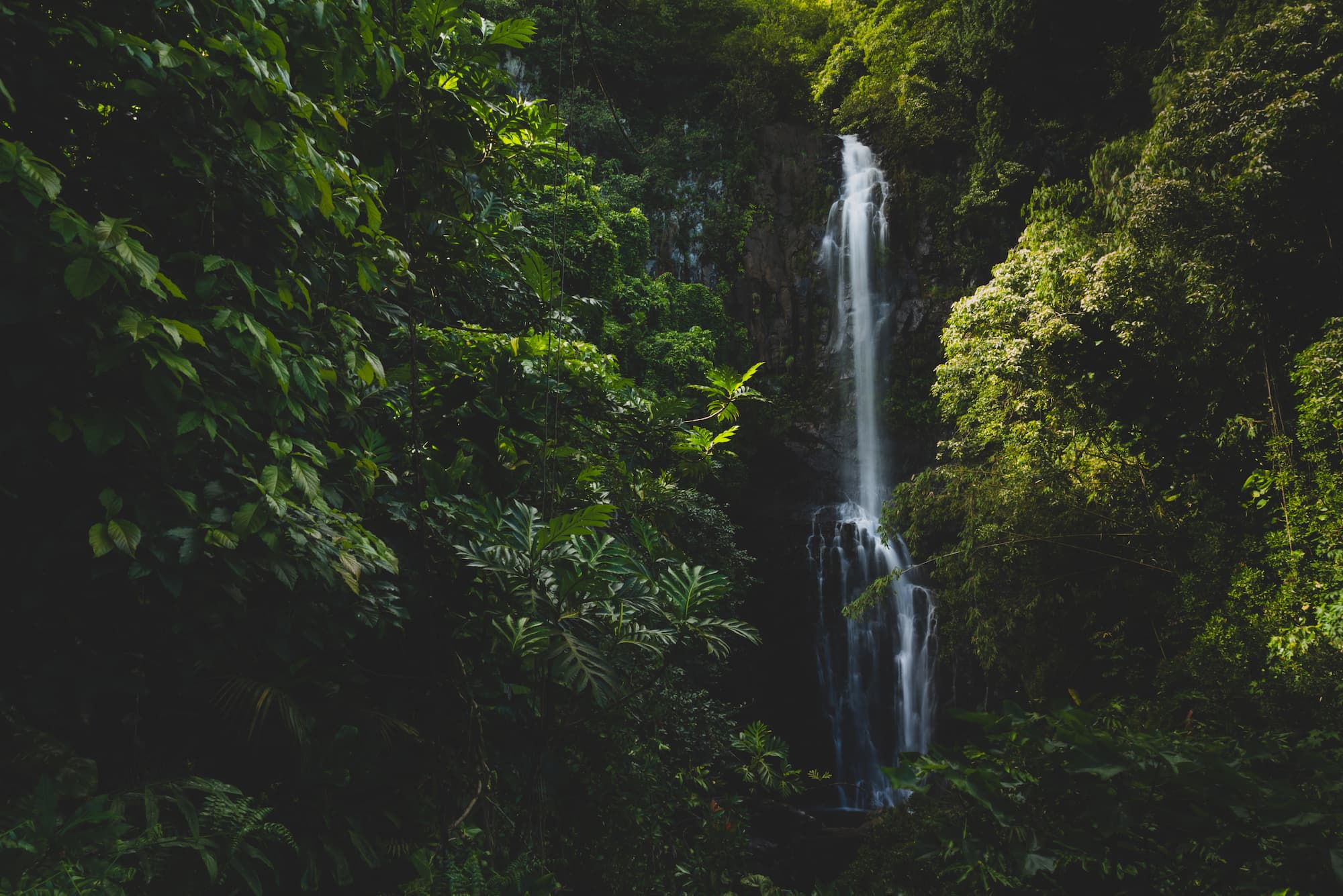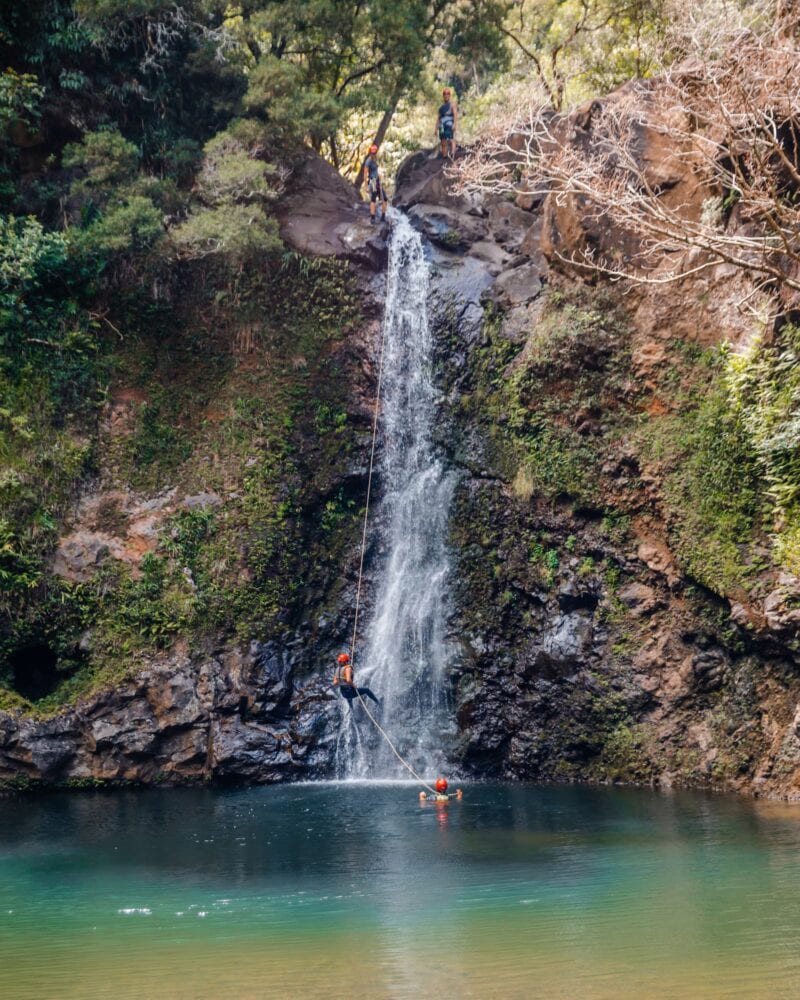Looking for big, magical, accessible, swimmable waterfalls? You’ve come to the right island. The northern and eastern parts of Maui are loaded with options, heavily concentrated along the infamous “Road to Hāna.” Swimming is possible at many of them, and in most cases, access requires only a short walk or hike.
Table of contents
- Safety tips (important!)
- Best waterfalls for… families, swimming, hiking, and accessibility
- Waterfall map
- List of waterfalls
- Waterfall adventures
Table of Contents
- Safety tips (important!)
- Best waterfalls for… families, swimming, hiking, and accessibility
- Waterfall map
- List of waterfalls
- Waterfall adventures
Below, we provide a list of Maui’s top waterfalls along with descriptions, recommendations, and a map to help you plan your visit.
Important things to know before visiting our waterfalls
Waterfalls are magical, no matter their shape or size, and visitors are encouraged to check out as many as possible while visiting Maui. Swimming is possible at many of them, and their jungle settings, depending on where you’re from, make them an otherworldly experience. To enjoy them safely, keep these rules of thumb in mind:
- Don’t swim if you have open cuts. Bacteria causing the Leptospirosis disease are present in Hawaiian streams. Open cuts and wounds are an easy way for it to enter your body.
- Don’t drink the water. Hawaiʻi’s water is pure, but bacteria are present and can make you sick. It’s not worth ruining your vacation. Bring your own water along with you.
- Wear water shoes or secured sandals when swimming. Jungle rocks are sharp and slippery, so it’s best to protect your feet when entering the water and swimming.
- Cliff jumping and rope swinging are bad ideas. While you may see locals engaging in such activities, it’s best to avoid them as a visitor. Locals are experienced and familiar with their surroundings and the underwater landscape; you are not. Engaging in these activities puts you at risk of serious injury or even death.
- Respect private property and other signs. You will see many waterfalls and other special sites along the Road to Hāna. It is imperative that you respect all private property and closed trail signs. Access areas only by official public routes and be sure your vehicle is legally and respectfully parked.
FAQ: What are the best waterfalls to visit for…
Maui has so many waterfalls to choose from that you might find yourself needing to narrow things down. Below, we answer some frequently asked questions about Maui’s waterfalls, including where to take your family, and where to go if you’re looking for adventure.
There are plenty of swimmable waterfalls to choose from on Maui. Families should try Twin Falls or Puaʻa Kaʻa Falls, while adventurers will enjoy Kopiliula Falls, Makamakaʻole Falls, or Punalau Falls.
There are many great family-friendly waterfalls to visit on Maui. Check out Alelele Falls, Twin Falls, Puaʻa Kaʻa Falls, Wailua Falls, and even Waimoku Falls.
Maui is blessed with easily-accessible waterfalls. Wailua Falls, Puaʻa Kaʻa Falls, and Upper Waikani are all right off the road.
Waimoku Falls, Twin Falls, Alelele Falls, and Makamakaʻole Falls are all great hike-to waterfalls.
Map of Maui waterfalls
Most of Maui’s waterfalls are located on the windwardside, along the Road to Hāna.
How to use this map: Above you’ll find a map of waterfalls on Maui. Click on the top left of the map to find separate layers marking the route and points of interest. You can hide and show different layers, or click icons on the map to see the names of waterfalls I mention in this guide. “Star” the map to save it to your own Google Maps, or open the map in a new window for a larger version. Enjoy!
List of accessible waterfalls
These waterfalls, reachable by a combination of car and foot, are your best options on Maui:
- Alelele Falls
- Kopiliula Falls
- Makahiku Falls
- Makamakaʻole Falls
- Puaʻa Kaʻa Falls
- Punalau Falls
- Twin Falls
- Waikani Falls
- Wailua Falls
- Waimoku Falls
Alelele Falls
Description: Alelele Falls is a 50-foot cascading falls located on the backside of Haleakalā, a little south of Kīpahulu. It is family friendly and easy to reach, just a short 1/3 mile trail that is well maintained. When rain has been plenty, there is a swimming pool at the bottom of the falls, which is majestically framed by the cliffs.
Good to Know: When traveling clockwise around the Road to Hāna, make this your final waterfall adventure as you make your way around. If there hasn’t been much rain, the falls can be weak, but the walk is pretty, and it is always worth taking a look.
The following 360° video (meaning that you can drag the video screen around in all directions) gives a good impression of the hike and the waterfall (at 5:10):
Kopiliula Falls (Wailua Iki Falls)
Description: Reaching this falls requires following a rocky, often-muddy stream bed – so it is not for beginners – but the hike is short, about a mile to mile and a half roundtrip. Those who go are rewarded with a peaceful place to sit beside Kopiliula Falls, surrounded by jungle in an uncrowded area.
Good to Know: The hike begins after mile marker 21 on the Road to Hāna. Bring slip-proof shoes and be prepared for mud.
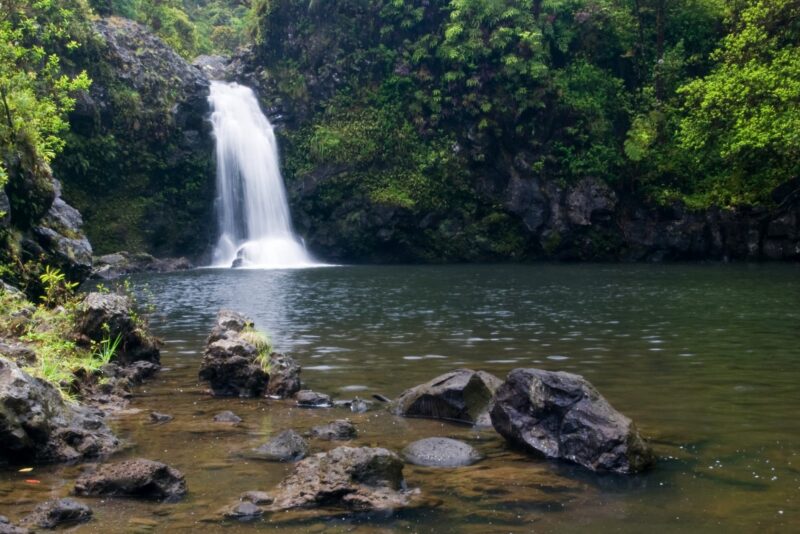
The Wailua Iki Falls. Image credit: Bruce Irschick, source.
Makahiku Falls
Description: The 200-foot Makahiku Falls is the source of the Seven Sacred Pools in the Kīpahulu section of Haleakalā National Park. It can be seen from a distance, from an overlook along the Pīpīwai Trail.
Good to Know: The area of Kīpahulu is a wonderful place to spend a half day or more. The Pīpīwai Trail also leads to the 400-foot Waimoku Falls (see below), and the nearby Seven Sacred Pools feature a series of small falls, located in a beautiful natural gulch.
Makamakaʻole Falls
Description: If you want an adventurous hike to a waterfall, Makamakaʻole, also known as 13 Crossings, makes for a fun afternoon. The trail follows the stream and crosses many times – about 13 – and ends at the multi-tiered Makamakaʻole Falls, about 270 feet in total. You’ll get great views of its segments while hiking and end at its base for a swim.
Good to Know: If you’re looking to avoid the hustle of the Road to Hāna and its many waterfalls, Makamakaʻole is located in northwest Maui and the hike takes you into the West Maui Mountains. Since you have to cross the stream, be prepared for mud and, as with all waterfall hikes, be aware of rain and flash flooding.
Puaʻa Kaʻa Falls
Description: Perfect for families who value a side of convenience with their waterfalls, Puaʻa Kaʻa falls is just off the Hāna Highway and has restrooms and picnic tables. Access to the falls is immediate, and swimming is possible as well. Hiking trails lead off farther into the jungle, for those who want to take a walk.
Good to Know: This is a highly-trafficked stop at Puaʻa Kaʻa State Wayside Park, so those looking for solitude should keep on driving.
Punalau Falls
Description: One hundred feet in height, Punalau Falls is reached by following the Punalau Stream into the jungle (just past mile marker 13 on the Road to Hāna). It’s a short but slippery scramble, only 15-20 minutes but not for beginners or families with small children because of the big, slippery rocks and lack of a maintained trail.
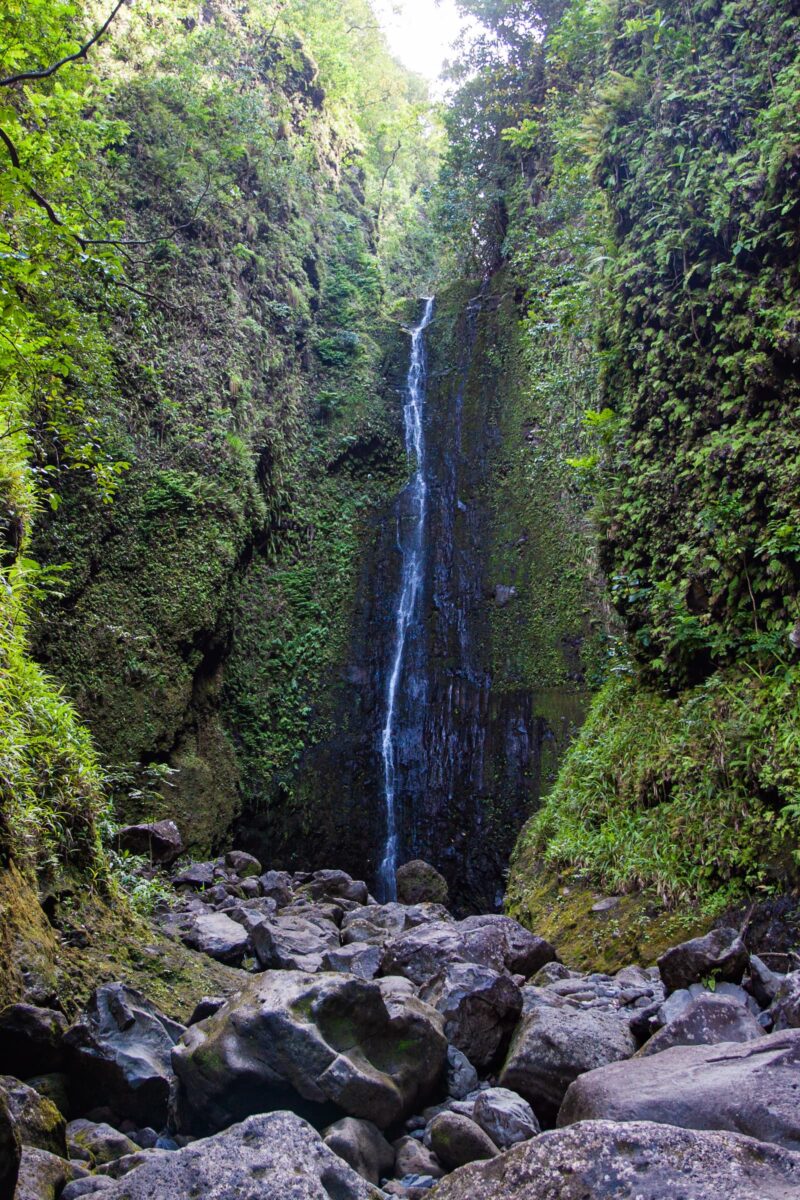
Punalau Falls is one of the lesser-known waterfalls along the popular Road to Hana. Our guess is that this is because the falls can’t be seen from the road, and require a short but slippery hike. Photo by Steve Wrzeszczynski (website).
Good to Know: This hike is best tackled with water-friendly shoes with good grip. The falls is not visible from the road, so it tends to be a little under the radar.
Twin Falls
Description: Twin Falls is the first major waterfall along the Hāna Highway, so naturally, it is one of the most-visited waterfall hikes on the entire island. The hike is family friendly and just three quarters of a mile, and it’s hard to argue the beauty of Twin Falls and its circular swimming pool.
Good to Know: There’s a farm stand located at the trailhead, so grab some snacks for the hike. Be patient when parking, as the area will be crowded.
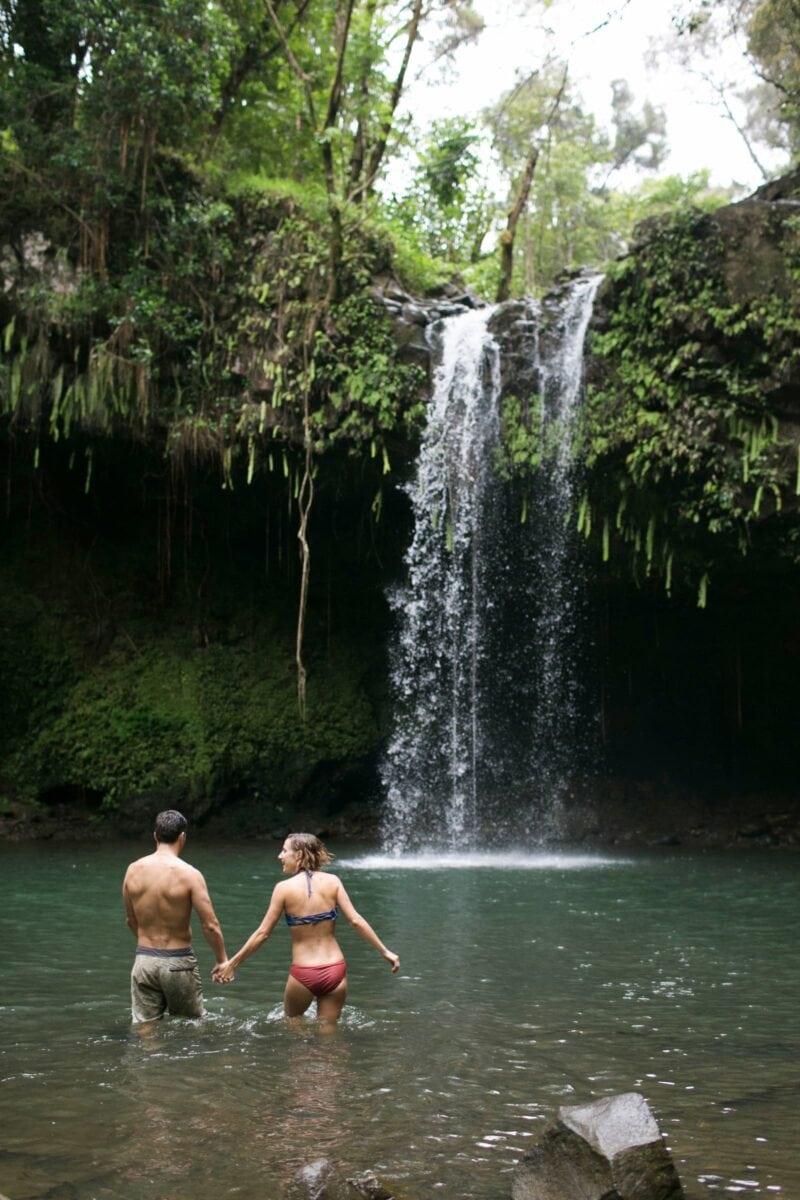
Located between mile marker 2 and 3, Twin Falls is the first easily accessible string of waterfalls and pools on the Road to Hana. Credit: Hawaii Tourism Authority (HTA)
Upper Waikani Falls
Description: Also known as Three Bears, Upper Waikani is unique in that it features three side-by-side-by-side 70-foot waterfalls. Need we say more?
Good to Know: Upper Waikani Falls is literally located right off the road, so close that you can see it when you drive by. Be patient in this area and drive carefully. When pulling off to park, be sure to do so in a safe area where no traffic is blocked.
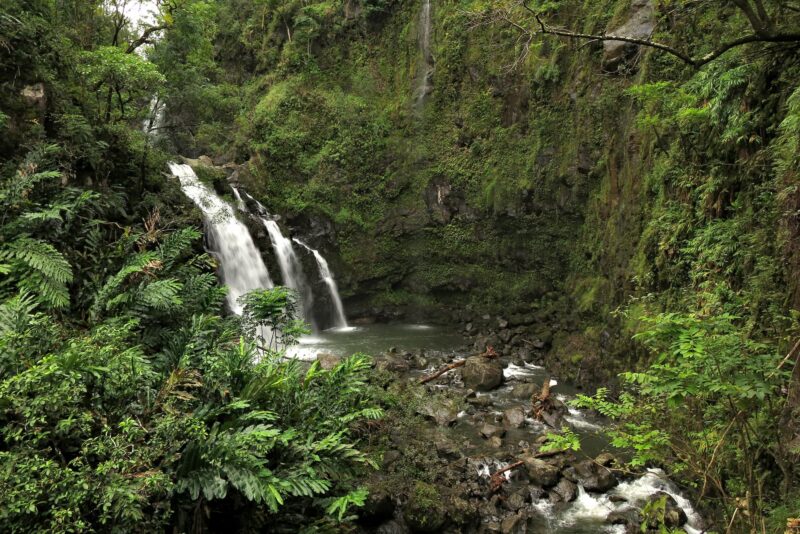
The upper Waikani Falls are a triple of large waterfalls amid rocks & lush vegetation. Image credit: Thomas Jundt, source.
Wailua Falls
Description: Wailua Falls is a classic waterfall along the Road to Hāna, 80 feet in height and located right off the road a few miles south of Hāna. Because of its accessibility, it is great for families or those wanting to avoid a hike. It does, as a result, get busy throughout the day.
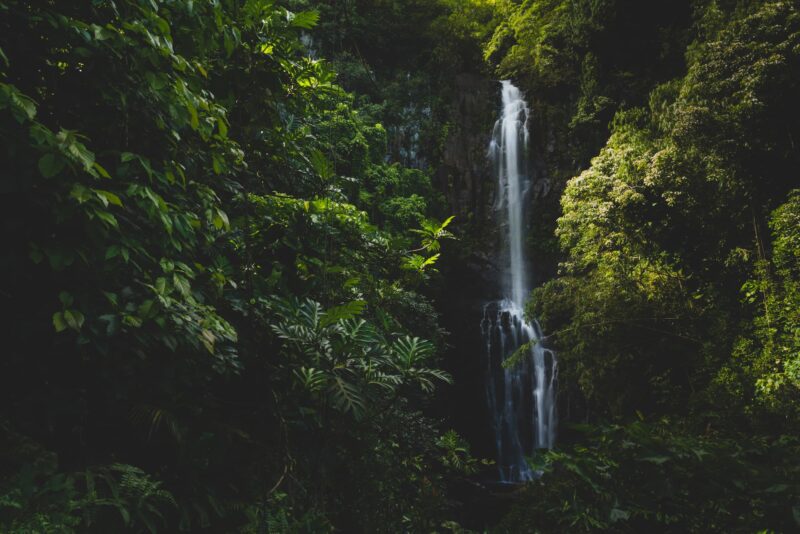
Wailua Falls on Maui. Photo by Ganapathy Kumar on Unsplash
Good to Know: Located close to the Kīpahulu section of Haleakalā National Park, this is a good waterfall to combine with an extended visit to the region. Close by are the Pipiwai Trail (Makahiku Falls) as well as the Seven Sacred Pools.
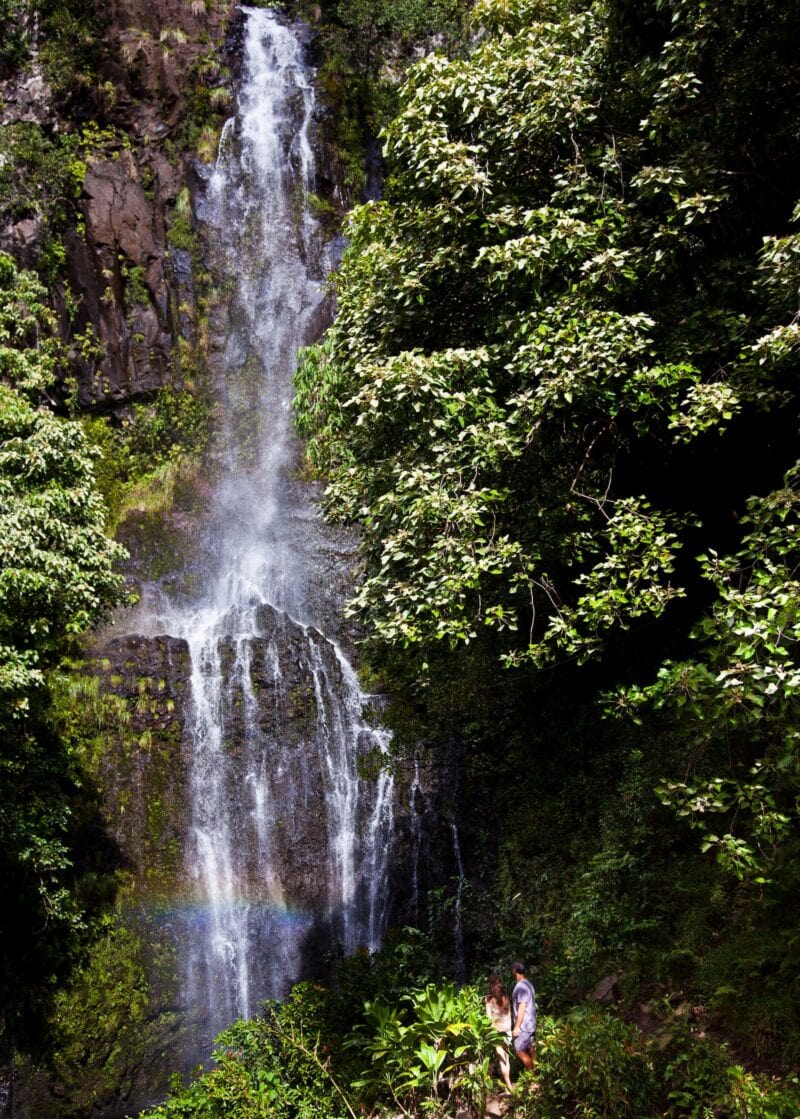
Wailua Falls are among the most photographed waterfalls on Maui – for good reasons! Image credit: Hawaii Tourism Authority/Tor Johnson.
Waimoku Falls
Description: The 400-foot Waimoku Falls is one of Maui’s best falls, not only because of its spectacular height and approachability, but because of the journey to get there. It is reached via the Pīpīwai Trail in the Kīpahulu section of Haleakalā National Park, 10 miles south of Hāna. It’s one of our favorite hikes on Maui not only because of Waimoku, but for its bamboo forest and its overlook of Makahiku Falls, too.
Good to Know: This waterfall hike can get crowded mid-day, so get there early. Or, consider camping at Kīpahulu and doing this hike first thing in the morning, before the day trippers arrive, to have it all to yourself.
Related waterfall guides
Can’t get enough Hawaiian waterfalls and looking for more information about waterfalls on other islands? Check out our related guides to Big Island, Kauaʻi, and Oʻahu:
- The best 5 waterfalls to visit on the Big Island
- 9 amazing Kauaʻi waterfalls
- Our 10 favorite waterfalls on Oʻahu
Waterfall Adventures
All waterfalls on our list are on public grounds and free to visit. There are, however, many more waterfalls here on Maui that are on private property and that can only be seen as part of a tour. Here are a few optinos if you are looking into the more adventurous waterfall activities:
Rappel down a Maui waterfall
Rappel Maui is located halfway down the famous Hana Highway and is home to Maui’s only rappelling tour. They have a private waterfall on their property which means you can get away from the traffic and the crowds while you rappel down a waterfall of your own.
